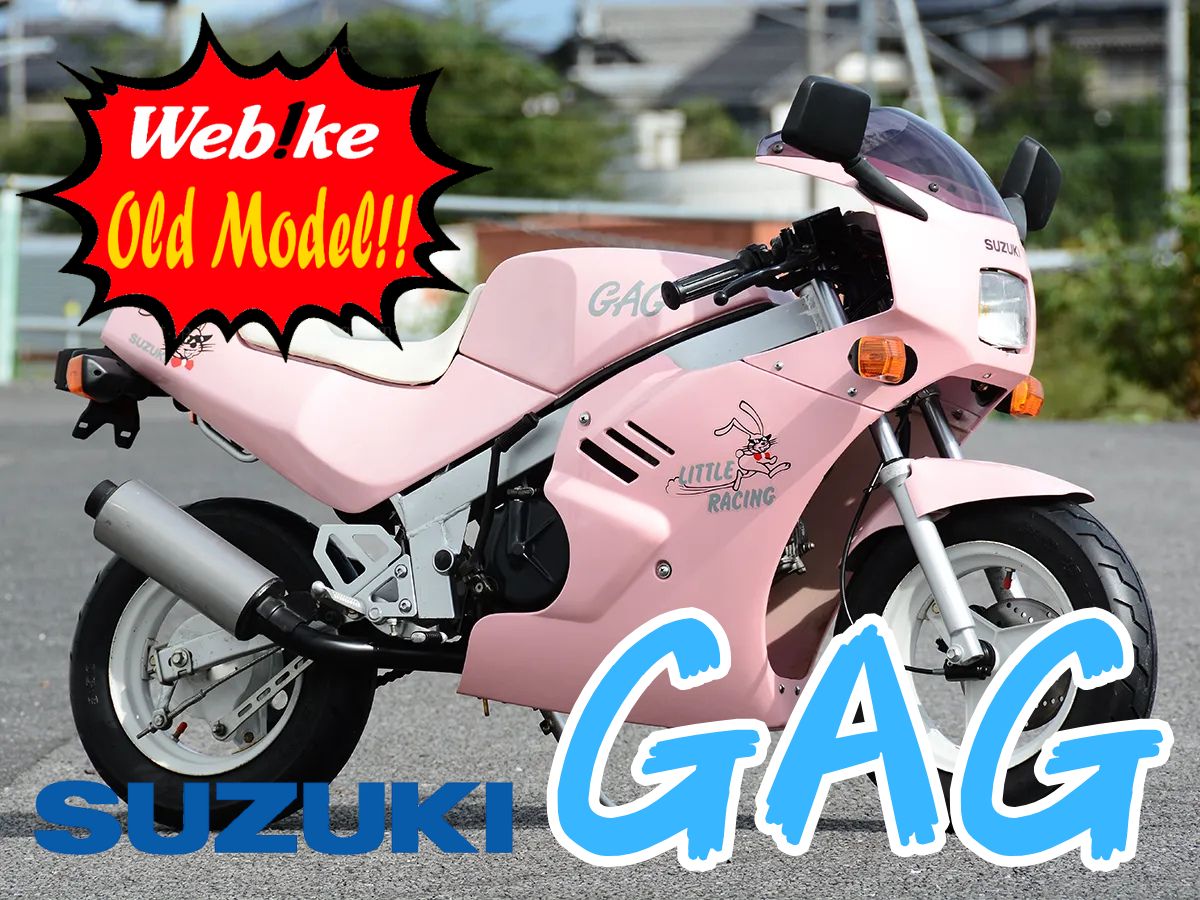Interview Assistance: Motorcycle King Tsukuba Out of Print Museum
The motorcycle boom of the 1980s, which could be described as enthusiastic, gave birth to a motorcycle culture known as racer replicas. Deregulation and technological advances caused motorcycles to evolve at an extraordinary speed, which spread to all sizes of engine displacement. Participation in races was also popular, and among them, 50-80cc minibike races became an important category that produced the next generation of world grand prix racers. The catalyst for such minibike racing was probably Suzuki's GAG, which we will introduce this time.
GAG born from the racer replica culture
Mini motorcycles have always been around, and trends change with each era. In modern times, Honda's CT series, such as the Cross Cub and Hunter Cub, are very popular, and other manufacturers have released models that follow suit. The Monkey, which can be said to be an eternal standard, has survived after several booms and has been converted to 125cc.
One of the trends in mini motorcycles is the "mini replica" boom that began in the 1980s. In the 1980s, with the introduction of Suzuki's RG250γ, racer replicas with large frame-mounted cowls became a big hit. Models that met the TT-F3 standard at the time, 250cc for two-strokes and 400cc for four-strokes, were released by each manufacturer, and the performance of the motorcycles themselves improved rapidly with repeated model changes almost every year.
As the racer replica boom heated up, Suzuki, the initiator of the racer replica boom, released a mini motorcycle named "GAG". The motorcycle has a full racer replica style with a full cowl, but its size is only about 3/4 of a normal motorcycle, and as its name suggests, it succeeded in making people laugh. After the appearance of the GAG, Yamaha released the YSR, and Honda released the Monkey R and NSR, and the "mini replica" boom began.

The GAG has good balance in all parts, such as the wheel size and the size of the cowling, so from a distance it looks like a full-size racer replica.

In addition to the "Pinks Character," the lineup included "Replica Character," "Patrol Plane Character," and "Pop Art Character."

The Monkey R, equipped with a four-stroke, air-cooled 50cc engine, could be considered a direct rival to the GAG.

The YSR was equipped with an air-cooled, two-stroke engine. An 80cc model was also available, and it participated in many minibike races.

The NSR, equipped with a water-cooled 2-stroke engine, was the last and most powerful minibike to appear. It was also available in an 80cc version and dominated minibike races.
Fully cowled + 4-stroke engine replica
In 1986, when GAG was released, Suzuki's racer replica lineup consisted of the 2-stroke RGγ and the 4-stroke GSX-R. The GSX-R came in 1100, 750, and 400 models, and its design was characterized by dual headlights like those of endurance racers, but the 400 model, which underwent a full model change in 1986, the same year as GAG, had a square headlight design for some reason. However, this square headlight model was unpopular with GSX-R fans, and the following year it was changed to dual headlights.
In contrast, the RGγ came in 500, 400, and 250 models, and all models had square headlights since their release. In other words, Suzuki decided to differentiate the design by having square headlights for the 2-stroke GP replica series and dual headlights for the endurance racer replica (base) GSX-R. The GAG itself was fitted with a four-stroke engine but had square engines, and its design was similar to that of the RGγ, but the coloring, named "Replica Character," was GSX-R-style, with the letter "R" printed on the under-cowl. Also, the side cover appears to have the "SACS" logo, which stands for the "Suzuki Advanced Cooling System" used in the GSX-R's oil-cooled engine, but on closer inspection it says "SUZUKI ADVANCED COMICAL SYSTEM," and humor is sprinkled throughout the details.

The "replica character" GAG has a color scheme reminiscent of Suzuki racer replicas such as the GSX-R and RGγ.

The original racer replica, the RG250γ, was the first model to feature an ALF frame and frame-mounted cowlings.

The GSX-R400 is equipped with a four-stroke, four-cylinder engine and features impressive dual headlights.
A 3/4 size replica motorcycle made with care
The engine installed in the GAG was an air-cooled 4-stroke SOHC 2-valve engine, borrowed from Suzuki's Birdy series of utility vehicles. While the Birdy's engine specs were maximum output 5PS/6500rpm and maximum torque 0.57kgm/6000rpm, the GAG was equipped with a slightly more powerful specification with maximum output 5.2PS/7000rpm and maximum torque 0.57kgm/6000rpm. While the Birdy had a rotary 3-speed transmission, the GAG had a 4-speed return type, and the clutch was also changed from an automatic centrifugal type to a manual type.

When you straddle it, you can clearly see its size. The handlebars are low and the riding position is cramped for its size.

The seat height is low enough that even children can reach the ground with their feet, so when an adult rides it, their knees feel like they have to bend.

The headlights are rectangular, and as a Suzuki racer replica, they follow the design of the two-stroke RGγ series.

The handlebars are a separate type that are attached under the top bridge, and the meter is sponge mounted in a racer style.

The front brake is a hydraulic disc brake, so there is a master cylinder on the right side of the handlebars.

The fuel tank, with its racer-style design, has a capacity of 7 liters, which is sufficient for a moped.

Being a moped, it is only natural that it is a one-seater, but it has a single seat with a very racy design.

The full cowling that extends to the under-cowl is fitted as standard, giving it an authentic racer style.

The taillights are built into the seat cowl, giving the rear area a clean design.

It uses an aluminum footpeg, which shows that a lot of effort has been put into it, which is hard to believe for a 50cc bike.

The silencer has an aluminum cover attached, giving it a racy design reminiscent of an aftermarket product.

The engine is an air-cooled, four-stroke engine like the Birdy, but the transmission has been changed to a four-speed return type.
The GAG's frame is made of steel, but uses a twin-tube type like a racer replica. The front has an upright hydraulic telescopic fork, and the rear has a single shock + square steel swingarm. The brakes are disc in the front and drum in the rear, and the wheels are 10 inches with a two-piece structure.

The wheel size was 10 inches. The wheel had a two-piece structure with the rim and spokes fastened together with bolts.

The front brake is equipped with a hydraulic disc brake, providing sufficient stopping power when needed.

The swingarm is made of square steel, and the rear wheel is the same 10-inch size as the front.

The rear brake is a drum type. The color around the wheel was changed to match the color of the body.
Looking at this GAG bike again, I was reminded that Suzuki, a manufacturer, can make incredible things when they get serious. RG250γ, GSX-R750, Katana, Hayabusa, etc. Everyone would agree that all of these had a huge impact on the motorcycle industry. GAG itself was a short-lived model, but without GAG, the NSR50 might not have been born. In other words, GAG can be said to have been the starting point of minibike racing, and it can be said that it later gave birth to many Japanese GP riders.
Hoping for a new GAG at a time of change for mopeds
The two-stroke NSR and YSR models have disappeared due to exhaust gas regulations, and 50cc engines are about to disappear from the lineup, so there will probably never be any GAG-sized bikes that can be used on public roads again. For mini bike racing, Honda's NSF100, which has a four-stroke engine on an NSR-type body, remains, but it cannot be used on public roads.
Mini bikes and mini bike racing were born as a category unique to Japa, and are an important category for Japanese motorcycle culture, having launched many riders into the world. At this time when the displacement of so-called mopeds is increasing to 125cc, new mini bikes will be created again. I hope that a new GAG-like entity will be born among them.
GAG Main Specifications (1986)
Overall Length x Width x Height: 1540 x 610 x 870 mm
Wheelbase: 1080mm
Seat Height: 610mm
Dry Weight: 64kg
Engne: Air-cooled 4-stroke SOHC 2-valve single cylinder 49cc
Maximum Output: 5.2PS/7000rpm
Maximum Torque: 0.57kgm/6000rpm
Fuel Tank Capacity: 7L
Transmission: 4-speed return
Brakes: F=disc, R=drum
Tire: F=3.50-10, R=3.50-10
Price: $1208.00 (price at that time)
Filming Support: Motorcycle King Tsukuba Out of Print Museum

This showroom has all kinds of out-of-print cars. There are also many different colors in stock, so you're sure to find one that suits your taste.
Address: 120 Kokinu, Tsukubamirai City, Ibaraki Prefecture Phone: 0297-21-8190 Business hours: 10:00-19:00 Closed: Thursdays



